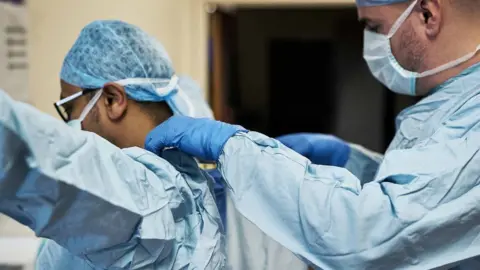Coronavirus: First official analysis finds PPE failings
 Getty Images
Getty ImagesThe availability of personal protective equipment (PPE) for health and care staff both before and during the Covid-19 pandemic has become one of the most intensely debated issues of the crisis.
Doctors, nurses and care staff in many settings warned that supplies were running low and they were concerned about their safety.
The National Audit Office (NAO) has now published the first official assessment of the supply and distribution of PPE in England by government organisations.
It highlights shortcomings in the system, though the Department of Health and Social Care has said that parts of the report are "misleading".
The NAO report, on the preparedness of the NHS and social care in England, states that the only stockpile available to meet increased demand for PPE in the early stages of the coronavirus outbreak was the one built up in anticipation of a pandemic flu crisis.
Crucially it did not contain gowns or visors. According to the NAO, the government's New and Emerging Respiratory Virus Threats Advisory Group (NERVTAG) recommended stockpiling gowns in June 2019.
The Department of Health told the NAO that "procurement of gowns was planned for early 2020".
The NAO report looks at the assumptions in Whitehall modelling for PPE requirements in a "worst case scenario".
Between mid March and early May, it says, the amount of face masks and clinical waste bags for use in health settings distributed from central stocks exceeded the modelled requirement but for all other items such as gowns, eye protectors and aprons it was lower.
For social care, the items distributed were all less than the modelled requirement, and with gloves and eye protectors it was below 10%.
'Worst case estimates'
The NAO adds that feedback from local providers revealed a large majority reporting that the PPE issue was having "a high or significant disruptive impact in their area across health and social care services".
The Department of Health's argument to the NAO was that NHS and social care organisations could purchase their own PPE to top up what was sent out from central stocks.
A spokesperson said: "We have delivered over 1.7 billion pieces of PPE and we continue to ensure supplies reach the frontline.
"The modelled PPE requirements presented in this report are theoretical worst case estimates - it is misleading to compare them to figures on centrally procured PPE which do not account for equipment supplied through other routes or existing local stocks."
The report paints a picture of confusion over the extent to which local NHS and care organisations were responsible for securing their own supplies of PPE at a time of global shortages in an unprecedented pandemic.
Central government opened up a dedicated central supply route in early April but for a while officials struggled to secure adequate stocks.
On May 1, the Department of Health wrote to NHS trusts saying PPE was being centrally managed and that hospitals should only do their own sourcing from new local suppliers.
By the middle of that month, says the NAO, central supplies of PPE were meeting demand from the health and care sectors.
Public Accounts Committee chair Meg Hiller said the government had "squandered the last opportunity to add to the central PPE stockpile, even after the NHS had gone to the highest level of alert."
She added: "Care homes were at the back of the queue for both PPE and testing so only got a small fraction of what they needed from central government. Residents and staff were an afterthought yet again: out of sight and out of mind, with devastating consequences."
The PPE debate wont go away.
The BBC's recent Panorama investigation highlighted some of the issues considered in the NAO report.
It may take a while for the full story to emerge including an assessment of how the UK authorities handled PPE procurement at a time when every leading healthcare system was struggling to acquire supplies. The NAO report is certainly an interesting early contribution to that debate.

- 40,000 DEATHS: Could they have been prevented?
- TESTING: Who can get a test and how?
- LOOK-UP TOOL: How many cases in your area?
- EUROPE LOCKDOWN: How is it being lifted?
- TWO METRES: Could less than 2m work?
- THE R NUMBER: What it means and why it matters
